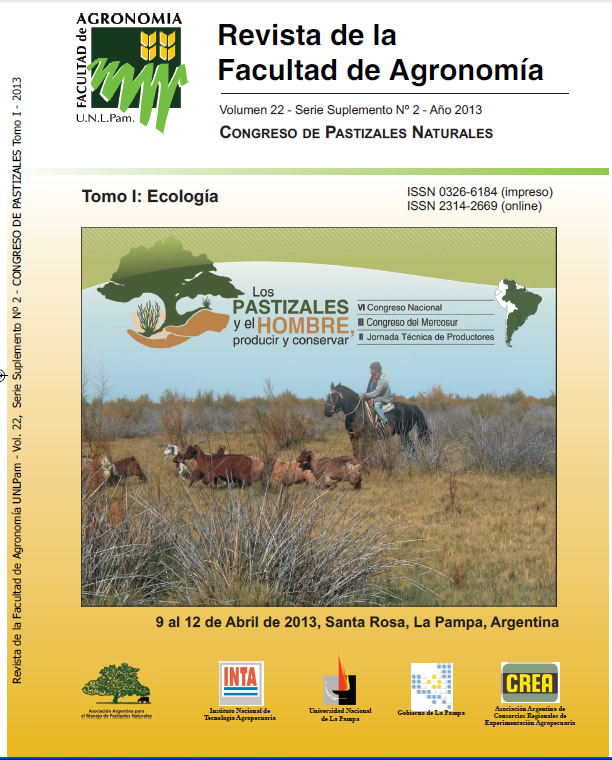Ewes and lamb performance managed with different grazing methods and herbage allowance in natural grassland
Keywords:
Continuous stocking, pampa Biome, rotational stocking, sheepAbstract
The objective of was to determine the influence of grazing methods with a relatively low or high herbage allowance in the first 84 gestation days on ewes/lambs daily weight gain (DWG) and area production. The study was conducted at an 8.4 ha natural grassland in South Brazil. During the winter, early pregnancy ewes were submitted to two grazing methods (continuous (CS) and rotative (RS) stoking) and two herbage allowances (HA; 12 and 18% live weight)), resulting in four treatments: CS18, CS12, RS18 and RS12. It was measured the DWG and body condition score (BCS) from ewes and from ewes and lambs after born, as well lambs area production. During the winter only the HA change the DWG from the ewes. During the spring differences were found only in the lambs DWG from grazing method, been higher in CS. A grazing method × HA interaction indicate that the higher lambs area production was achieved in the CS12 treatment. The results indicate that the grazing methods and HA had a little influence in the animal performance over winter and the herbage could be better used in this period.
Downloads
References
David D.B. 2008. Recria de cordeiras suplementadas em campo nativo: níveis de atendimento das exigências nutricionais e suas relações com a resposta animal. Porto Alegre: UFRGS. Dissertação de Mestrado - Universidade Federal do Rio Grande do Sul. pp.135.
Moojen E.L & G.E. 2002. Potencial produtivo de uma pastagem nativa do Rio Grande do Sul submetida a níveis de oferta de forragem. Ciênc. Rural 32(1): 127-132.
Russel J.F., M. Doney & R.G. Gunn. 1969. Subjective assessment of body fat in live sheep. J. Agric. Sci. 72: 451-454.
Soares A.B. 2002. da alteração da oferta de matéria seca de uma pastagem natural sobre a produção animal e a dinamica da vegetação. Tese (Doutorado). Faculdade de Agronomia, Universidade Federal do Rio Grande do Sul, Porto Alegre. pp. 187.
Wilm H.G., O.F. Costelo & G.E. Klippe. 1944. Estimating forage yield by the double sampling method. J. Am. Soc. Agron. Geneva 36: 194-203.
NRC (National Research Council). 2007. Nutrient requirements of small ruminants: sheep, goats, cervids and new world camelids. Washington: National Academy Press. pp.362.
Downloads
Published
Issue
Section
License
La Editorial de la Universidad Nacional de La Pampa (EdUNLPam) exigirá a los/as autores/as la firma del siguiente documento:
La EdUNLPam lleva a cabo la publicación del artículo: (Título del Artículo) en SEMIÁRIDA Rev.Fac.Agron UNLPam ISSN 2362-4337 (impresa) ISSN 2408-4077 (en línea), del cual el/los abajo firmantes son autores de una o más partes. En el mismo acto, el/los autores entregan exclusivamente a la EdUNLPam todos sus derechos protegidos por las leyes de propiedad intelectual que rigen en la Argentina para reproducir, publicar, editar, fijar, comunicar y transmitir públicamente en cualquier formato o medio impreso o electrónico, inclusive internet, el artículo enviado a publicación e incluirlo en índices o bases de datos nacionales e internacionales. A cambio, la EdUNLPam entrega a los autores la autorización para la publicación o reimpresión con ines académicos y educativos en cualquier libro o medio de divulgación, con la sola obligación de citar el artículo original publicado en la EdUNLPam. Cada autor acuerda en que el material provisto a la EdUNLPam es un trabajo original, que no ha sido impreso o publicado en cualquier otro medio con anterioridad y que no vulnera derechos de terceros. El Primer autor tendrá la posibilidad de leer y corregir el artículo ya editado como “prueba de galera”, pero si el autor no devolviera esas correcciones de la prueba de galera dentro del tiempo especificado, el proceso de producción y publicación podrá proseguir sin la aprobación del autor. El/los autor/es no recibirán compensación monetaria de la EdUNLPam por el uso del material contenido en este artículo y asumen la responsabilidad de las opiniones vertidas en él.






.png)



22.png)



.jpg)




.jpg)
